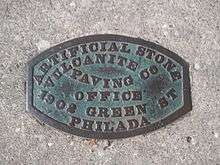Artificial stone


Artificial stone is a name for various kinds of synthetic stone products used from the 18th century onward. As well as artistic uses, they have been used in building construction, civil engineering work, and industrial uses such as grindstones.
Information
One of the earliest was Lithodipyra (also called Coade stone), a ceramic created by Eleanor Coade (1733–1821), and produced from 1769 to 1833. Later, in 1844, Frederick Ransome created a Patent Siliceous Stone, which comprised sand and powdered flint in an alkaline solution.[1] By heating it in an enclosed high temperature steam boiler the siliceous particles were bound together and could be moulded or worked into filtering slabs, vases, tombstones, decorative architectural work, emery wheels and grindstones.
This was followed by Victoria stone, which comprises finely-crushed Mountsorrel (Leicestershire) granitesolid surface and Portland cement, carefully mixed by machinery in the proportions of three to one and cast in moulds of the required shape. When the blocks are set hard the moulds are loosened and the blocks placed in a solution of silicate of soda for about two weeks for the purpose of indurating and hardening them.[2] Many manufacturers turn out a material that is practically non-porous and is able effectually to resist the corroding influence of sea air or the impure atmosphere of large towns.
Most later types of artificial stone have consisted of fine cement concrete placed to set in wooden or iron moulds. It could be made more cheaply and more uniform than natural stone, and was widely used. In engineering projects, it had the advantage that transporting the bulk materials and casting them near the place of use was cheaper than transporting very large pieces of stone.
Modern cast stone is an architectural concrete building unit manufactured to simulate natural cut stone, used in unit masonry applications. Cast stone is a masonry product, used as an architectural feature, trim, ornament or facing for buildings or other structures. Cast stone can be made from white and/or grey cements, manufactured or natural sands, carefully selected crushed stone or well graded natural gravels and mineral coloring pigments to achieve the desired colour and appearance while maintaining durable physical properties which exceed most natural cut building stones. Cast stone is an excellent replacement for natural cut limestone, brownstone, sandstone, bluestone, granite, slate, coral rock, travertine and other natural building stones.
Engineered stone
Engineered stones are the latest development of artificial stones, it was invented in the early 1980s and have since been continuously developed by the Italian company Breton S.P.A.'s late founder Marcello Toncelli.
Engineered stones are a mix of marble powder, resin, and pigment cast using vacuum oscillation to form blocks. Slabs are then produced by cutting, grinding, and polishing. Some factories have developed a special, low-viscosity, high-strength polyester resin to improve hardness, strength, and gloss and to reduce water absorption.
There are two major varieties of engineered stones based on the main composition of its aggregates (stone powders), marbles and quartz. The process is more or less similar except in certain details, however the two product have different commercial applications.
Engineered marbles are most commonly used as flooring for large commercial projects. Engineered quartz is widely used in the developed world for counter tops, window sills, and floor and wall coverings.
The vast majority of engineered stone companies are located in Greater China, India, and its birthplace in Italy.
Bibliography
| Wikimedia Commons has media related to Artificial stone. |
-
 This article incorporates text from a publication now in the public domain: Chisholm, Hugh, ed. (1911). "article name needed". Encyclopædia Britannica (11th ed.). Cambridge University Press., s.v. 'stone'
This article incorporates text from a publication now in the public domain: Chisholm, Hugh, ed. (1911). "article name needed". Encyclopædia Britannica (11th ed.). Cambridge University Press., s.v. 'stone' - George Ripley, ed., The American Cyclopædia: A Popular Dictionary of General Knowledge, 1873 s.v. 'concrete'
References
- ↑ Robertson, J. C. (1845). "Specifications of Recent English Patents". The Mechanics' Magazine. London: James Bounsall. 42: 441.
- ↑ https://books.google.co.uk/books?id=3jsDBAAAQBAJ&dq=%22victoria+stone%22&source=gbs_navlinks_s